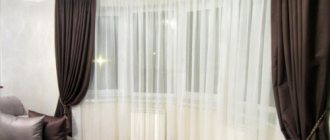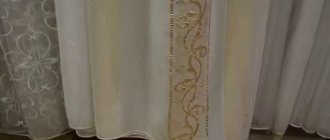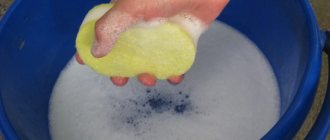Rules for selecting suitable tulle
The first step to creating decor is choosing fabric. You need to take color into account. It must match the interior. Neutral options are white shades. You can use old cuts, but you will have to first wash them in an automatic washing machine and select undamaged scraps. The fabric must be clean and smooth.
Fans of minimalism will love the simple canvas without additional details.
It is better not to purchase textiles with a dense, thick pattern. It will transmit light poorly. It is allowed to use lace instead of tulle, but its cost is higher.
Why glue tulle to the window?
The demand for decor is explained by the abundance of advantages. Advantages:
- simple work that does not require special tools and skills;
- the absence of a cornice or baguette, which is problematic to install yourself;
- the ability to select tulle that matches the decor of the room;
- reliable window protection from prying eyes;
- using a window sill not covered with curtains as a shelf for flower pots, decorative vases, etc.;
- low cost of gluing tulle onto glass compared to buying fabric and sewing curtains.
Often, old lace curtains that have not lost their appearance are used to decorate windows.
Disadvantages of the method:
- the canvas limits the entry of sunlight into the room;
- tulle on windows facing the roadway quickly becomes dirty;
- the synthetic material gradually acquires a yellow tint;
- Incorrectly prepared glue leaves streaks on the glass.
It turns out that decorative design with lace is more functional, more original and more economical than classic design.
Features of preparation
The window must be clean, otherwise the pasting will not be successful. Due to dust and dirt particles, the fabric will not adhere well to the surface. For washing, you can use a soap solution or special products.
There should be no water on the glass during the procedure. It will worsen the adhesion of the fabric to the surface. For this reason, it is advisable to glue tulle in the warm season. In winter, it is recommended to hang the curtains and wait, as condensation will interfere with decoration. In the case of plastic windows, the time of year does not matter.
How to hang curtains on the balcony
The simplest option is a rod cornice. It consists of a rod, fasteners, guides, and brackets. Curtains can be attached to it using hooks, eyelets, rings, clips, fabric loops on the canvas, and decorative ties.
| Cornice length | Curtain length | Curtain width |
| Window width + allowances of 20-30 cm on each side + size of ends + 5-7 cm of free distance to the wall. | The height of the cornice at the bottom of the window + allowances for hemming and creating a drawstring + 5-7 cm, if you need a curtain below the window. | The length of the cornice section between the fastenings. If you want curtains with folds, you should add another 1.5 lengths to the figure. |
Advice! If the balcony is not rectangular in shape, semicircular or flexible curtain rods are suitable for attaching curtains. They are fixed on wall or ceiling brackets.
Semicircular cornice on the balcony
Curtains with decorative ties
Step-by-step instructions for preparing starch-based glue
The cooking method depends on what starch is used.
If corn, the procedure will be as follows:
- Starch is diluted in cold water in a 1:1 ratio.
- Pour boiling water into the mixture in a thin stream. For 0.5 liters of glue you will need 3 tbsp. l. starch.
- The mixture is thoroughly stirred and cooled before use.
You cannot combine pure starch with boiling water without skipping the first step. This will cause lumps to form.
When using potato starch, the task is simplified: 1 tbsp. l. powder is mixed with 3 liters of warm water. The liquid must not be brought to a boil.
It is recommended to choose only snow-white starch, otherwise the glue will turn yellow under sunlight. The consistency of the finished mixture should be creamy. Glue that is too thick or thin will make the decorating process difficult.
Completing of the work
You can glue tulle to a window with synthetic glue, but this is not the best option, since it has the following disadvantages:
- Turns yellow when exposed to sunlight.
- Increased temperatures may result in the release of unpleasant chemical odors.
- More difficult to separate from surfaces.
Therefore, to create lace on a window, it is better to prepare glue yourself from starch; such a product will be natural and environmentally friendly. You can make glue from corn or potato starch.
Making corn glue
Necessary:
- water - 400 ml;
- corn starch - 2 tablespoons;
- container for mixing the solution - 1 piece;
- wooden spoon or spatula - 1 pc.
Cooking method:
- Mix starch with 2 tablespoons of cold water.
- Mix well so that no lumps appear.
- Boil the remaining water and pour into the solution, stirring the ingredients regularly.
- Stir until the glue is homogeneous.
- Wait until it cools down.
The glue is ready.
To glue tulle to glass, you should use high-white starch so that the solution does not turn yellow after a while and spoil the appearance.
Recent Entries
Patchwork with knitting needles: instructions for using the technique for beginners and amateurs How and with what to paint laminate flooring and is it possible to do it at all: we talk about the intricacies of the process Wedding invitations: a review of the best ideas with a detailed description of the manufacturing process
Making potato glue
Necessary:
- water - 3 l;
- potato starch - 1 tablespoon;
- container for mixing the solution - 1 piece;
- wooden spoon or spatula - 1 pc.
It is better to choose first grade starch.
Cooking method:
- Heat the water to 40 degrees.
- Pour warm water into a container.
- Add powder and stir thoroughly until dissolved. The glue is ready.
Before gluing the tulle, you should thoroughly wash the glass on which the decor will be glued. Windows must be clean and dry.
Having prepared everything you need, you can start decorating the window.
The first step is to make a tulle pattern.
- Measure the height and width of the glass with a ruler or tape measure.
- Transfer measurements onto paper or cardboard using a ruler and pencil.
- Make allowances of 5 mm on each side, this is necessary for shrinkage of the fabric. After gluing, the glue will dry for some time and tighten the fabric.
- Cut out the pattern.
- Iron the tulle; there should be no gathers on it.
- Attach the paper pattern to the fabric using pins.
- Trace the pattern with chalk or remaining soap.
- Cut out the tulle blank.
Apply the resulting pattern to the window and check whether the measurements are taken correctly. Do this with each window.
There are two ways to glue the decor.
Without immersing the workpiece in glue
- Apply glue to the glass surface with a brush.
- Place the workpiece on the glass and carefully spread it over the entire surface.
- Go over the fabric again with a brush with glue.
For better adhesion, the glue is first applied in broad strokes, then the edges of the tulle are smeared.
How to glue tulle to window glass
First, a suitable size piece or curtain strip is cut out of the canvas, if the decoration does not involve complete gluing. To do this you will need a measuring tape or ruler.
If you are dealing with already used fabric, after washing you need to select areas without stains, protruding threads or other defects. Please check the correct dimensions in advance.
The sticker should completely cover the edges. When wet, it may shrink slightly, so it is better to leave a margin of 3-5 mm.
You can glue tulle in 2 ways. The first involves applying glue to the glass surface; the fabric is applied starting from the top of the window. After fixing, an additional layer of composition is applied over the cut. At the end, folds and irregularities are straightened, voids are eliminated and excess glue is removed.
Another method is to starch the fabric itself. The flap is immersed in the mixture. To do this, it is recommended to dilute the glue in a flat container. The curtain is taken out when it is completely saturated with liquid. The cut is squeezed out to remove excess glue and attached to the surface of the window. At the end, the fabric is straightened and all defects are eliminated, then allowed to dry.
Regardless of the method, the pasting procedure is carried out indoors. They try to avoid drafts.
What kind of tulle can be glued to glass?
The choice of material is an important step. It all depends on the purpose of designing the window bay and the quality characteristics of the canvas:
- Lightweight fabric is optimal. Tight cuts will not last long on a slippery surface and will fall off under their own weight.
- The web made of synthetic and natural silk fibers is quite strong and delicate. Often the patterns repeat the pattern of snowflakes. Looks good on windows in rooms with light walls.
- Guipure or machine-knitted tulle emphasize the sophistication of the interior. But handmade samples are too heavy for glass.
- Gluing old transparent curtains fits into the “country” and “Provence” styles.
It is not necessary to buy snow-white fabric. Inserts with colored patterns look interesting on windows. It is not difficult for craftsmen who have mastered the method to create real stained glass windows.
Advantages and disadvantages of decor
The advantages of gluing tulle include the following factors:
- Price. The price of glue is low, so it can be neglected. Medium size canvas - 1000-2000 rubles. This cut is enough to decorate several windows.
- Ease of execution. The only mistakes that can be made are choosing a defective area of the fabric, using a yellowish powder and leaving folds. Pasting takes little time: you do not need to starch or carefully iron a large piece.
- Possibility of replacing fabric. If you get tired of the pattern, you can easily remove the cut at any time.
- Functionality. Fabric can not only decorate a room, but also protect the room from bright sunlight. The tulle partially hides what is happening inside from passersby.
- Space saving. Hanging curtains visually makes the room smaller. Thanks to tulle, you can do without a cornice.
How to remove glued tulle
The fabric on the window is changed periodically. The main reasons are contamination of the material and glass, outdated design.
There is a simple method:
- Use a regular sponge, which is moistened in hot water and pressed to the surface.
- The lace absorbs moisture, the glue softens and the tulle easily comes away from the glass.
- Instead of foam rubber, you can “arm yourself” with a napkin or spray.
Sticking tulle decorates not only the windows, but the entire room. Using various fabrics, it is easy to emphasize the originality of the design and save on the purchase of classic curtains. And in order for the work to be of high quality, it is advisable not to neglect step-by-step technology.
Tips and tricks
It is not recommended to glue tulle from the outside. In the best case, the cut itself will get wet due to the rain and fall off, in the worst case, you will not be able to remove it. The fabric will become dirty over time as dust accumulates on it. Due to sunlight, the flap will partially melt and adhere more tightly to the glass. As a result, you will spend 8-10 hours to remove the fabric.
On sale you can find ready-made glue for gluing tulle. It is not recommended to use it. This composition is not safe; after the procedure, it emits an unpleasant odor. Over time it will turn yellow, so the appearance of the fabric will deteriorate. In the future, it will be more difficult for you to remove the tulle from the window.
It is advisable to carry out work wearing gloves. This will prevent skin contact with the glue.
Try not to let the compound come into contact with the plastic frame. If the excess thickens, you will have a hard time removing it.
Useful tips
When gluing the material, you can use useful tips:
- Many people, in order not to bother with preparing glue, buy synthetic glue. What to do is not recommended. The use of synthetic material will lead to yellowing from sunlight, an unpleasant odor will be released, and it will make it difficult to dismantle the material.
- When preparing the paste, you need to obtain a medium consistency, otherwise a very liquid or thick consistency will complicate the gluing process.
- Use starch with increased whiteness, which will help avoid yellowing.
- When choosing fabric, avoid stains and thread ends.
- When applying glass dimensions to the tulle, you need to take into account allowances of about half a centimeter on each side (if you follow this advice, you will not need to unnecessarily stretch the fabric soaked in the solution).
- Work with rubber gloves (you can wear regular medical gloves), which will help keep the skin of your hands intact.
- If the surface consists of several openings, do not apply glue to each glass at the same time.
- If possible, select fabric of the required shade to match the color of the room.
- If you need to peel off the tulle, it won’t cause any problems. To do this, just use a washcloth with hot water. The washcloth is soaked in hot water, then applied gradually to the entire surface where the tulle is glued (the entire fabric should be well saturated). Wait a few minutes for the water to dissolve the glue. After which you can remove the material and wash the glass.
Decorative adhesive film
Decorative window stickers instead of curtains are a great option if you want to add decorations and decor to your room. They are easy to glue and will stand out in contrast against the background of an empty wall. The design of window stickers can be anything: with colorful patterns or monochrome patterns on a matte background.
Photo: freshome.com
What is required to decorate the window?
Below is a complete list of everything you need:
This is all! No threads, no cornices. All that is required is to achieve the desired consistency of starch and carefully cut the appropriate size tulle for the window. Using a tape measure, measure the window (length and width).
Do not forget that, just in case, you need to add an allowance of one centimeter. That is, 0.5 cm on each side of the tulle.
For now, without glue, we apply the tulle to the window to make sure that we really cut everything out correctly. If necessary, we make minor edits. Now all that remains is to glue the tulle directly to the glass.
Paintings or panels
This window decor is perfect for a creative space. Paintings of different sizes will help turn your home windows into a real gallery. It is better to use this option if your home has large panoramic windows - they will accommodate more works of art and the decor will become more pronounced.
Photo: ilevel.biz
What glue to use for gluing decor?
No adhesive can be removed without leaving traces, except for the paste. Making the simplest glue from starch is not difficult. Plus, once it dries, it doesn't leave any residue.
The glue proportions are as follows: for 3 liters of water, 1 tablespoon of potato starch. After thorough mixing in warm water, the glue is ready for use. But you don’t need to apply it to the window with a brush.
It is quite liquid and by the time you go to get the tulle, the glue will have completely flowed onto the window sill. It is recommended to do the following. Select a small container and pour the glue into it. Naturally, not three liters of glue are required. The above proportion was given solely as an example of the water/starch ratio.
We completely immerse the tulle in the glue. The lower part comes first and then the tulle is laid in an accordion pattern. You need to wait until the tulle is well saturated with glue. We take it out, squeeze it out a little and apply it to the window.
Kitchen window decor done!
Olga Papsueva will clearly demonstrate how to decorate a kitchen window yourself:
A beautifully designed window can transform any room. But not every window is suitable for curtains or curtains. In small rooms, they visually reduce the size of the room, look heavy, and sometimes even inappropriate. For this and other reasons, blinds have become popular as window decoration. However, their manufacture and installation require time and considerable expense. Therefore, now an unusual and original method of decoration has become increasingly used - tulle glued to the window.











